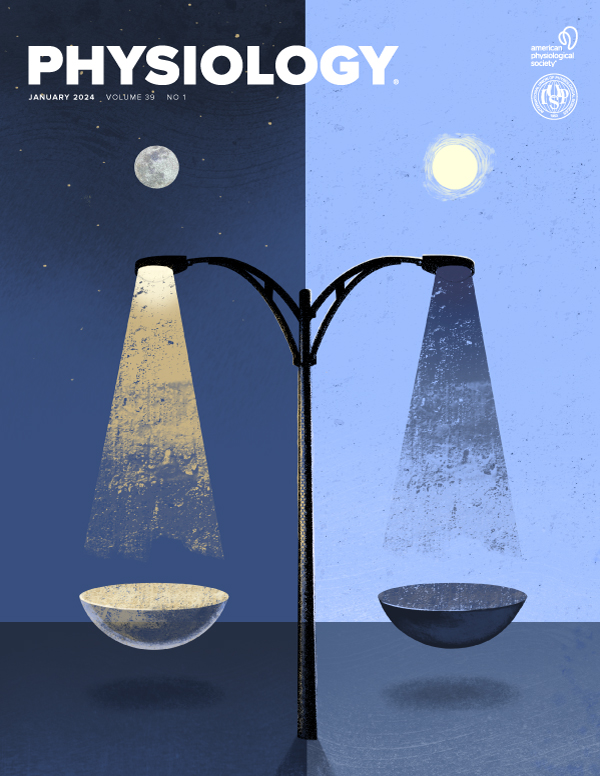GLP-1 对小鼠缺血性卒中后星形胶质细胞命运的影响
IF 5.3
2区 医学
Q1 PHYSIOLOGY
引用次数: 0
摘要
中风是大多数发达国家成年人身体和智力残疾及死亡的主要原因之一。对缺血性中风的研究大多集中在神经元病理机制和神经元死亡方面,试图通过阻止有害病理过程或提高神经元活力来挽救神经元。虽然星形胶质细胞是哺乳动物中枢神经系统(CNS)中最丰富的细胞,但它们曾被忽视过一段时间,近年来又重新成为关注的焦点。星形胶质细胞在维持中枢神经系统正常功能和应对各种中枢神经系统损伤和疾病方面发挥着多重作用。星形胶质细胞对中枢神经系统损伤的反应既有有害影响,也有有益影响。以往的研究表明,星形胶质细胞对缺血性中风的炎症反应可能会破坏缺血性病灶,但其他星形胶质细胞反应则会导致抗兴奋毒性、分泌神经营养因子、神经发生、突触生成、轴突重塑和血管生成等促进神经保护的作用。胰高血糖素样肽-1(GLP-1)对神经元的有益作用已被深入研究,但关于 GLP-1 对星形胶质细胞的作用的研究并不多。我们的早期研究发现,激活 GLP-1 受体可预防缺血诱导的脑细胞死亡,并通过免疫组化(IHC)观察到缺血后 3 天的小鼠脑半月区中新出现的神经元祖细胞来自星形胶质细胞。RT-PCR、免疫印迹和免疫荧光结果也清楚地表明星形胶质细胞表达了 GLP-1 受体。此外,Western 印迹结果显示,给予 GLP-1 类似物 exendin-4(EX-4)可抑制氧-葡萄糖剥夺(OGD)处理的小鼠原发性星形胶质细胞中促炎蛋白的表达。有趣的是,我们还观察到,在中风脑的 IHC 图像中,梗死部位的 DNA 损伤严重,GFAP 阳性星形胶质细胞较少;相反,半月区的 GFAP 阳性星形胶质细胞较多,DNA 损伤较少。结果表明,A1 和 A2 星形胶质细胞在缺血性大脑和恢复中发挥着一定的作用。本研究的目的是确定GLP-1参与星形胶质细胞命运决定的机制,以及减少有害影响和扩大有益影响的方法,从而可能开发出治疗缺血性中风的创新疗法。该研究得到了台湾国家科学技术委员会 108-2320-B-182A-005-MY3 和 112-2320-B-182A-003- 的支持。本文是在 2024 年美国生理学峰会上发表的摘要全文,仅提供 HTML 格式。本摘要没有附加版本或附加内容。生理学》未参与同行评审过程。本文章由计算机程序翻译,如有差异,请以英文原文为准。
The Role of GLP-1 Affects Fate of Astrocytes Following Ischemic Stroke in Mice
Stroke is one of the leading causes of physical and intellectual disability and mortality in adults of most of the developed countries. The most of studies in ischemic stroke focus on neuronal pathological mechanisms and neuronal death trying to rescue neurons via stopping the detrimental pathological processes or enhancing neuronal viability. Although astrocytes are the most abundant cells and in mammal central nervous system (CNS), they were ignored for period of time but are return to spotlight in recent years. Astrocyte play multiple roles in maintain normal function of central nervous system and respond to all kinds of CNS injury and disease. Responses of astrocytes to CNS damage lead to both detrimental and beneficial consequences. Previous studies have reported that astrocyte inflammatory responses to ischemic stroke may devastate the ischemic lesion, but other astrocytic responses lead to anti-excitotoxicity, secreting neurotrophic factors, neurogenesis, synaptogenesis, axonal remodeling, and angiogenesis promoting neuroprotective effects. Glucagon-like peptide-1 (GLP-1) have been intensively studied on beneficial effects of neurons, but not many studies work on effects of GLP-1 to astrocytes. Our early study has found that activation of GLP-1 receptors prevented ischemia-induced brain cell death and observed newly neuronal progenitor cells were from astrocyte-lineage in penumbral area of 3-day post-ischemic mouse brains by immunohistochemistry (IHC). RT-PCR, immunoblotting, and immunofluorescent results also clearly indicated the astrocytes expressed GLP-1 receptors. Furthermore, Western blotting results showed administration of GLP-1 analogue, exendin-4 (EX-4), suppressed expression of pro-inflammatory proteins in oxygen-glucose deprivation (OGD) treated mouse primary astrocytes. Interestingly, we also observed that infarct site obtained sever DNA damage and less GFAP positive astrocytes, on contrary, the penumbral area had more GFAP positive astrocytes and less DNA damage in IHC images of stroke brains. The results implied that A1 and A2 astrocytes play certain roles in ischemic brains and recovery. The goal of this study is to determine the mechanisms of GLP-1 involving in astrocytic fate decision and approach on minimizing detrimental effects and amplifying the beneficial effects, which possibly develop innovative therapies for ischemic stroke. The study is supported by 108-2320-B-182A-005-MY3 and 112-2320-B-182A-003- from Taiwan National Science and Technology Council. This is the full abstract presented at the American Physiology Summit 2024 meeting and is only available in HTML format. There are no additional versions or additional content available for this abstract. Physiology was not involved in the peer review process.
求助全文
通过发布文献求助,成功后即可免费获取论文全文。
去求助
来源期刊

Physiology
医学-生理学
CiteScore
14.50
自引率
0.00%
发文量
37
期刊介绍:
Physiology journal features meticulously crafted review articles penned by esteemed leaders in their respective fields. These articles undergo rigorous peer review and showcase the forefront of cutting-edge advances across various domains of physiology. Our Editorial Board, comprised of distinguished leaders in the broad spectrum of physiology, convenes annually to deliberate and recommend pioneering topics for review articles, as well as select the most suitable scientists to author these articles. Join us in exploring the forefront of physiological research and innovation.
 求助内容:
求助内容: 应助结果提醒方式:
应助结果提醒方式:


